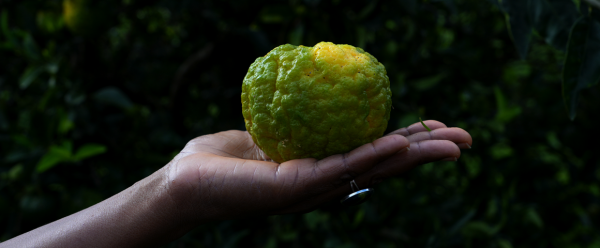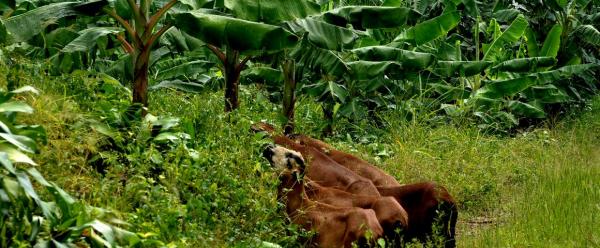Science at work 19 December 2025
- Home
- CIRAD news
- News
- Conflict resolution – improving the co-existence of humans and wildlife
Conflict resolution – improving the co-existence of humans and wildlife
-89.JPG)
(©Brent Stirton-Getty Images for FAO, CIFOR, CIRAD, WCS)
The Kavango Zambezi Transfrontier Conservation Area, more commonly known as KaZa TFCA, is a vast conservation area covering 520,000 km² and five countries (Angola, Botswana, Namibia, Zambia, and Zimbabwe). Large populations of wildlife move constantly, often across national borders, as the environment, resources and weather changes. The majority of wildlife lives and moves outside the 36 protected areas found within KaZa, and there is regular interaction with the 2.53 million people living in the region.
With low and erratic rainfall and high temperatures, rural communities in this savannah landscape wage a daily battle to procure enough food from livestock farming and small-scale crop cultivation. Hyena and lions are common visitors, killing goats, sheep, cattle and poultry, while elephants can devour crops in a matter of hours, destroy granaries and on occasions cause loss of human life. In addition, some agro-pastoralists rely on illegal hunting of wildlife to supplement their diets and earn cash.
In an effort to reduce human-wildlife conflict (HWC) and improve diets, incomes and access to water, the SWM Programme, under the coordination of CIRAD, is working with communities in north west Zimbabwe and southern Zambia on land-use planning, livelihood projects and HWC mitigation measures. CIRAD has long experience of the challenges involved in managing land-use conflicts in the Kavango-Zambezi Transfrontier Conservation Area (KaZa-TFCA), whose massive territory includes the KaZa project site.
Devolving rights and management to local communities: a win-win solution
The foundation for the SWM Programme interventions is the formalization and establishment of community conservancies (CC). The CC model was first developed in Namibia over twenty years ago, and is based on community-led land-use planning and management, rooted in respect of communities’ rights to their traditional resources.
“The community conservancy system devolves power from the local authorities to the communities themselves,” said Maxwell Phiri, CIRAD technical assistant in the SWM Programme KaZa team. “The idea is to empower the communities so that they manage the land, and any benefits go directly to them.”
Facilitated by the SWM Programme, local communities are creating the institutions to manage three new community conservancies – two in Zambia (MIZE and one in Zimbabwe (Mucheni CC). CIRAD is working with the respective government ministries and other partners to strengthen the legal and institutional frameworks for the CCs, and the rights of the people who live on them. It will take a few years for CCs to be up and running, and generating nature-based incomes for the local communities whilst as the same time increasing wildlife populations. Involving communities in every step of project design and implementation is essential, explains the CIRAD communications officer Martha Katsi.
“The local people must own and directly benefit from the community conservancies on their traditional or communal land,” she said. “We need to build a sense of ownership. Once the communities see that it pays to manage their natural and wildlife resources then there will be sustainability.”
Improving livelihoods and nutrition
As part of the SWM Programme strategy in KaZa, the team is also working with communities on improved livestock and fish farming activities, to improve rural food security and as alternative sources of protein to consuming wild meat. For example, at the Mucheni CC site in Zimbabwe, 36 improved goat breed bucks (i.e. Boer and the Kalahari) were introduced in 2021, which have resulted in over 250 kids. Their larger, more robust frames mean more meat and higher market prices for the villagers.
In parallel, livestock infrastructure has been rehabilitated, including dip tanks to protect animals from ticks, and cattle pens to serve as market hubs where people can sell livestock and other goods. In Zambia, community-managed fishponds have been created and stocked with fingerlings as a potential source of protein and income. To address the problem of lack of water the project is drilling boreholes, with separate water points for humans and animals.
Strengthening wildlife management
In addition, in 2022 the SWM Programme assisted the translocation of impala, zebra and kudu to help restock the wildlife populations in the planned Mucheni CC. Once the wildlife populations grow, they will be attract new nature-based enterprises to the CC, which the communities may then decide to partner with for either consumptive (e.g. sustainable hunting) or non-consumptive (e.g. photographic safaris) uses. To reduce poaching and ensure that the natural resources within the CC are well managed a cadre of community Resource Monitors have also been trained and employed.
These interventions have already started to change local mindsets. “Before, people saw wildlife as negative, because of the damage they caused, but if they see they can get an income from the wildlife and can protect their livestock, then they have an incentive to conserve them,” said Martha Katsi. She cites the case of a farmer who lost 20 goats to hyenas. A new system of mobile bomas – protected animal enclosures that have been set up to deter attacks by predators – has significantly reduced livestock losses. In an effort to stop elephants from destroying crops, chilli pepper is being planted in a move that has a dual benefit – deterring elephants and producing extra revenue.
A toolbox for community engagement
Ensuring community participation, ownership and leadership is an essential part of the SWM Programme approach. To that end, the initiative follows a community rights-based approach and has a series of social safeguards in place, which ensures that local and indigenous communities:
- participate and are included in an equitable manner in all project activities;
- are empowered in their legal use and sustainable management of natural resources; and
- can strengthen their capacity to manage and benefit from wildlife.
Social safeguards are new to the conservation sector and have rarely been applied in large-scale conservation projects.
“In Gabon, as everywhere, we are very careful about how we engage with communities,” explains Hadrien Vanthomme. “The series of social safeguards offers a framework or toolbox that we use when working with communities. These safeguards are designed to ensure that SWM Programme responds to the needs of the community, and that activities are defined and developed in a participatory manner with them.”
The social safeguards include five principles and tools:
- A community rights situation analysis
- The Free, Prior and Informed Consent protocol, a step-by-step approach that guide all the activities with local communities
- A six-step approach to achieve gender equality and women’s empowerment
- Research ethics
- A grievance redress mechanism
“Working closely with the communities is probably the most important feature of the SWM Programme,” said Patrice Grimaud, the CIRAD SWM Programme Coordinator in the KaZa site. “This set of tools goes a long way towards helping us to do this effectively.”



























